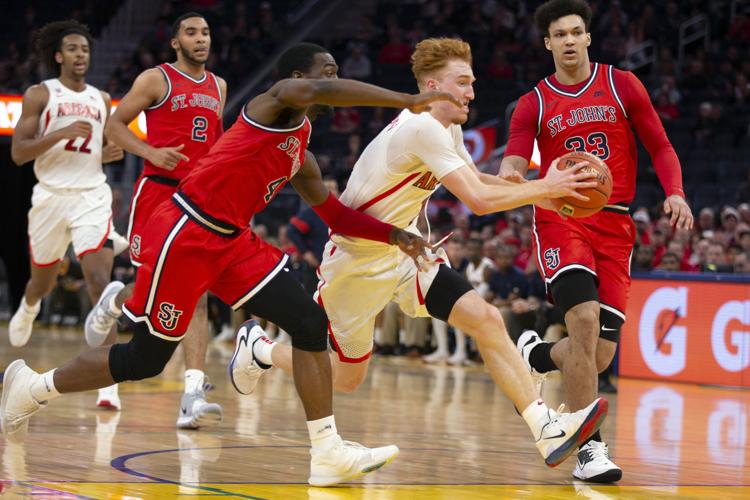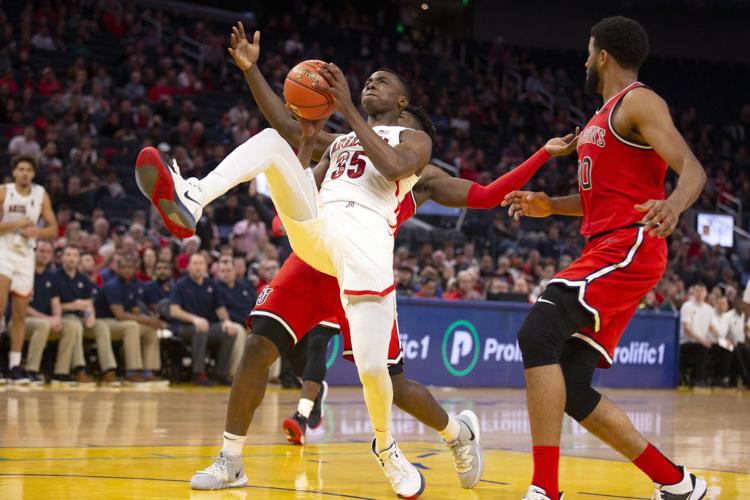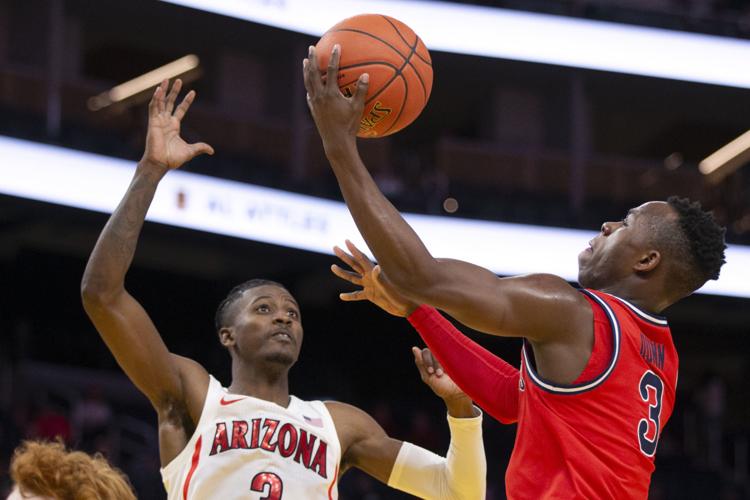SAN FRANCISCO — They were both shots Nico Mannion has made many times already this season, a long 3-pointer from the top of the key and a floater as he drove right of the basket, an easier version of the shot he used to beat Pepperdine in the final seconds last month.
Neither went in.
This time, Mannion missed them both within the final 30 seconds, leaving No. 16-ranked Arizona stuck with a 70-67 loss Saturday to St. John’s at the Chase Center.
“You know,” UA coach Sean Miller said after the game, “when you lose tough games, a lot of times the spotlight’s on the last play or plays. But every play is the same. It’s being really good at the end of the first half. It’s going into halftime, not down 14, taking care of the ball the first 20 minutes (when) we had 10 turnovers.”
Miller had a point. Regardless of Mannion’s continued shooting problems, or the play call Miller made to get it to him at the end (Miller noted that St. John’s switched from man-to-man to zone to defend UA’s final play), the bottom line is this:
In each of their three losses so far this season, the Wildcats have trailed by 16 or more points, rallied to make it close near the end, but ultimately couldn’t close the deal.
For coaches, players and fans alike it can be a maddening trend.
“It’s not just how you finish games,” guard Max Hazzard said. “It’s every play within the game.”
So why did the Wildcats appear to unable to match St. John’s energy early in Saturday’s game? Why did they give up five turnovers in the first six minutes, despite initially beating the Red Storm’s backcourt pressure?
Why did they give up seven St. John’s offensive rebounds in the first half? Why did they collect only one offensive board themselves during that time? And why do they continue to struggle from 3, making only 1 of 8 in the first half and 2 of 8 in the second?
“A big part of our loss today was the deficit that we had throughout the game,” Miller said. “I can make the argument that we rallied and we played maybe our best basketball towards the end, whether the last play goes in or doesn’t go in, that remains to be seen.”
If any of this was making Miller sweat, it didn’t show. He wore a windbreaker on the sideline, noting that “in events like this sometimes the coaching staffs talk and I think (dressing casually) was our agreement.”
But it was clear afterward he was agitated. Among other things, the rebounding that he has already repeatedly referred to as UA’s “Achilles’ heel” did not improve.
Against a smaller frontcourt, the Wildcats were outrebounded 40-35 and gave up 13 offensive rebounds, fortunate that St. John’s scored only eight second-chance points off them.
Miller quickly converted those into offensive rebounding percentages, the true indicator of how a team is doing on the glass, and those numbers appeared even worse.
“The advantage we have is our size,” Miller said. St. John’s “will be one of the smaller teams that we play all season long. And yet they were the bigger, tougher team on the glass. They were getting 44% of their misses back at halftime. We’re getting 7%.”
Then he talked about those early turnovers. UA had 10 of them at halftime, and St. John’s converted those into 14 mostly easy points.
The dagger was an errant pass from Dylan Smith with 29 seconds left before halftime, leading eventually to a layup from St. John’s LJ Figueroa thanks also to UA’s defensive efforts.
“The last two plays of the first half, we had a turnover that was kind of unforced on a 3-on-2 and we went for a shot fake on the last play that gave Figueroa a running one hander off the glass,” Miller noted. “Instead of us maybe going down 10 points into halftime and ending it with our ball, we go down 14 points. Those are all plays that I think in the first half really characterized our team.”
Smith’s late first-half turnover was his fourth and he did not play at all in the second half, along with forward Ira Lee. When asked about their absences, Miller cited Smith’s turnovers as a reason and, with Lee, said only that center Christian Koloko deserved more of an opportunity (Lee had three rebounds in six minutes over the first half.)
Then there was the shooting. Also having preached often this season that the Wildcats’ propensity to play fast ideally should include also playing smart, the Wildcats played fast and, well, loose.
UA finished shooting 39.6% overall but made just 3 of 16 3-pointers (18.8%).
“In the first half, we shot insane shots, (past the line for) 3s by players that shouldn’t be shooting them,” Miller said. “With the NBA (3-point) line being on the court, we might have taken five or six NBA 3s and that speaks to our lack of poise, our lack of confidence at the beginning of the game.
“But we certainly gained more confidence as the as the game grew on and we’ve gotta be that type of team for longer periods of time.”






